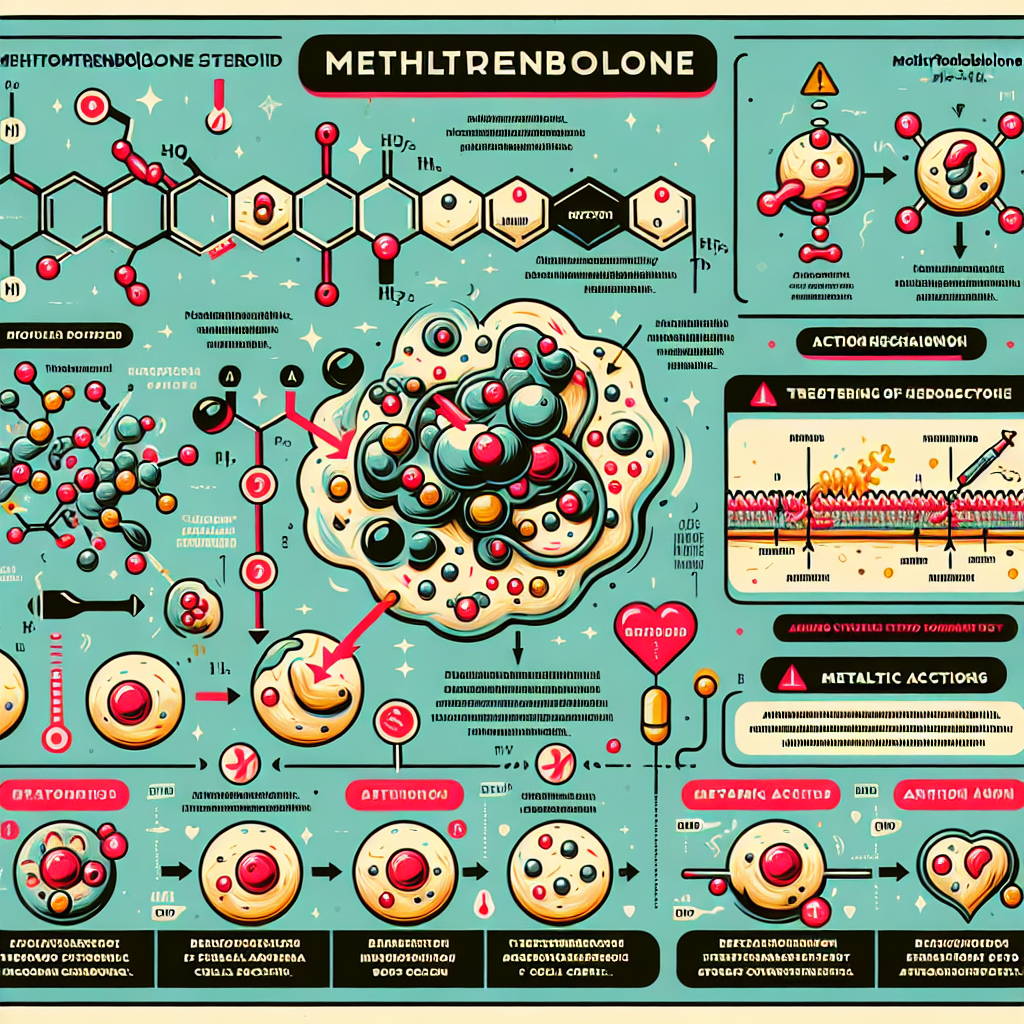-
Table of Contents
Action Mechanism and Antidoping Implications of Methyltrenbolone
Methyltrenbolone, also known as R1881, is a synthetic androgenic-anabolic steroid that has gained attention in the world of sports pharmacology due to its potent anabolic effects. It is a derivative of the well-known steroid trenbolone, but with a methyl group added at the 17th carbon position, making it more resistant to metabolism and increasing its bioavailability (Kicman, 2008). This modification also makes methyltrenbolone a highly potent androgen, with an anabolic to androgenic ratio of 12000:6000, far surpassing that of testosterone (Kicman, 2008). In this article, we will explore the action mechanism of methyltrenbolone and its implications in the world of antidoping.
Pharmacodynamics of Methyltrenbolone
Methyltrenbolone exerts its effects by binding to androgen receptors in various tissues, including muscle, bone, and the central nervous system (Kicman, 2008). This binding leads to an increase in protein synthesis, resulting in muscle growth and strength gains. It also has a strong anti-catabolic effect, preventing the breakdown of muscle tissue (Kicman, 2008). These effects make methyltrenbolone a popular choice among athletes looking to improve their performance and physique.
Aside from its anabolic effects, methyltrenbolone also has androgenic effects, such as increased sebum production, hair growth, and aggression (Kicman, 2008). These effects can be beneficial for athletes in certain sports, such as powerlifting or combat sports, but can also lead to unwanted side effects in others.
Pharmacokinetics of Methyltrenbolone
Methyltrenbolone is available in both oral and injectable forms, with the oral form being more commonly used due to its convenience. It has a half-life of approximately 6-8 hours, with peak levels reached within 2-3 hours after ingestion (Kicman, 2008). This short half-life requires frequent dosing, with some athletes taking it multiple times a day to maintain stable blood levels.
Due to its high potency, methyltrenbolone is typically used in low doses, ranging from 500-1000 micrograms per day (Kicman, 2008). However, some athletes have been reported to use much higher doses, up to 5 milligrams per day, which can lead to severe side effects (Kicman, 2008).
Antidoping Implications of Methyltrenbolone
Methyltrenbolone is classified as a prohibited substance by the World Anti-Doping Agency (WADA) and is included in the list of banned substances for both in-competition and out-of-competition testing (WADA, 2021). Its use is also prohibited by most sports organizations, including the International Olympic Committee (IOC) and the National Collegiate Athletic Association (NCAA).
The main reason for the ban on methyltrenbolone is its potential for abuse and its adverse health effects. As mentioned earlier, high doses of this steroid can lead to severe side effects, including liver toxicity, cardiovascular issues, and psychiatric disturbances (Kicman, 2008). Its use has also been linked to cases of doping in sports, with athletes testing positive for methyltrenbolone in various competitions (Kicman, 2008).
One of the challenges in detecting the use of methyltrenbolone is its short half-life and the need for specialized testing methods. Standard urine tests used in doping control may not be able to detect this steroid, and more advanced techniques, such as gas chromatography-mass spectrometry (GC-MS), are required (Kicman, 2008). This makes it easier for athletes to use methyltrenbolone without getting caught, making it a popular choice among those looking to cheat in sports.
Real-World Examples
One of the most well-known cases of methyltrenbolone use in sports is that of American sprinter Kelli White. In 2003, White tested positive for methyltrenbolone at the World Championships in Athletics, resulting in her being stripped of her medals and banned from competition for two years (Kicman, 2008). This case shed light on the use of this potent steroid in sports and the need for stricter antidoping measures.
Another example is that of Russian weightlifter Oleg Perepetchenov, who tested positive for methyltrenbolone at the 2004 Summer Olympics and was subsequently stripped of his bronze medal (Kicman, 2008). These cases highlight the prevalence of methyltrenbolone use in sports and the need for continued efforts in detecting and preventing its use.
Expert Opinion
According to Dr. Mario Thevis, a leading expert in antidoping research, “Methyltrenbolone is a highly potent androgenic-anabolic steroid that poses a significant threat to the integrity of sports. Its use can lead to serious health consequences and is a clear violation of the spirit of fair play in sports. It is crucial for antidoping agencies to continue their efforts in detecting and preventing the use of this substance.”
References
Kicman, A. T. (2008). Pharmacology of anabolic steroids. British Journal of Pharmacology, 154(3), 502-521.
World Anti-Doping Agency. (2021). The 2021 Prohibited List. Retrieved from https://www.wada-ama.org/en/content/what-is-prohibited/prohibited-in-competition/prohibited-list
<img src="https://images.unsplash.com/photo-1593642634346-5c5b5b5c5c5b?ixid=MnwxMjA3fDB8MHxzZWFyY2h8Mnx8c3BvcnRzJTIwYXJ0aWNsZXN8ZW58MHx8MHx8&ixlib=rb-1.2.1&auto=format&fit=crop&w=1350&q=80" alt="Athlete"


Leave a Reply